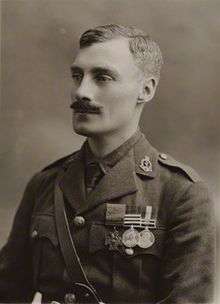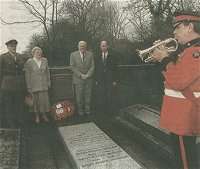Arthur Martin-Leake
| Arthur Martin-Leake | |
|---|---|
 Arthur Martin-Leake c.1902 | |
| Born |
4 April 1874 Standon, Hertfordshire |
| Died |
22 June 1953 (aged 79) High Cross, Hertfordshire |
| Buried at | High Cross Church |
| Allegiance |
|
| Service/branch | British Army |
| Years of service |
|
| Rank | Lieutenant Colonel |
| Unit | |
| Commands held | 46th Field Ambulance |
| Battles/wars | |
| Awards | Victoria Cross & Bar |
Lieutenant Colonel Arthur Martin-Leake VC & Bar (4 April 1874 – 22 June 1953) was a British double recipient of the Victoria Cross, the highest award for gallantry in the face of the enemy that can be awarded to British and Commonwealth forces. Martin-Leake was the first of only three men to be awarded the VC twice.
Early life
Arthur, the fifth son of Stephen Martin-Leake of Thorpe Hall, Essex,[1] was born at Standon, near Ware, Hertfordshire, and was educated at Westminster School before studying medicine at University College Hospital, qualifying in 1893. He was employed at Hemel Hempstead District Hospital before enlisting in the Imperial Yeomanry, to serve in the Boer War in 1899.[2]
Boer War
Martin-Leake first served in the Second Boer War as a trooper in the Imperial Yeomanry. After his year service was completed he stayed on in South Africa as a civil surgeon. He then joined the South African Constabulary until he was forced to return home due to his wounds.
He was 27 years old, and a surgeon captain in the South African Constabulary attached to the 5th Field Ambulance during the Second Boer War on 8 February 1902, at Vlakfontein when he won his first VC.
During the action at Vlakfontein, on the 8th February, 1902, Surgeon-Captain Martin-Leake went up to a wounded man, and attended to him under a heavy fire from about 40 Boers at 100 yards range. He then went to the assistance of a wounded Officer, and, whilst trying to place him in a comfortable position, was shot three times, but would not give in till he rolled over thoroughly exhausted. All the eight men at this point were wounded, and while they were lying on the Veldt, Surgeon-Captain Martin-Leake refused water till every one else had been served.[3]
He received the decoration from King Edward VII at St James's Palace on 2 June 1902.[4]
Interbellum
Martin-Leake qualified as a Fellow of the Royal College of Surgeons in 1903 after studying while convalescing from wounds. He then took up an appointment in India as Chief Medical Officer with the Bengal-Nagpur Railway.[2]
In 1912 he volunteered to serve with the British Red Cross during the Balkan Wars, attached to the Montenegran army, and was present during the Siege of Scutari (1912–13) and at Tarabosh Mountain. He was awarded the Order of the Montenegran Red Cross.[2]
First World War
On the outbreak of the First World War Martin-Leake returned to service, as a lieutenant with the 5th Field Ambulance, Royal Army Medical Corps, on the Western Front.[2]
He won his second VC, aged 40 years, during the period 29 October to 8 November 1914 near Zonnebeke, Belgium whilst serving with the Royal Army Medical Corps, British Army.
His award citation reads:
Lieutenant Arthur Martin Leake, Royal Army Medical Corps, who was awarded the Victoria Cross on 13th May, 1902, is granted a Clasp for conspicuous bravery in the present campaign: —For most conspicuous bravery and devotion to duty throughout the campaign, especially during the period 29th October to 8th November, 1914, near Zonnebeke, in rescuing, whilst exposed to constant fire, a large number of the wounded who were lying close to the enemy's trenches.[5]
His Victoria Cross is displayed at the Army Medical Services Museum, Aldershot, England.
He was promoted captain in March 1915, major in November the same year, and in April 1917 took command of 46th Field Ambulance at the rank of lieutenant colonel.[2]
Postwar
Martin-Leake retired from the army after the war and resumed his company employment in India until he retired to England in 1937. Although there is no record of his being a pilot, he was registered in 1939 as the owner of a De Havilland Moth Minor aircraft, registered G-AFRY [6]
During the Second World War he commanded an ARP post.[2]
He died, aged 79, at High Cross, Hertfordshire. Following cremation at Enfield, Middlesex, Martin-Leake was buried in St John's Church, High Cross. He is commemorated with a plaque and a tree at the National Memorial Arboretum in Alrewas, Staffordshire.

Other holders of the VC and bar
- Captain Noel Godfrey Chavasse of the Royal Army Medical Corps received the VC for tending wounded soldiers under fire on 9 August 1916, at Guillemont, France. The Bar was received posthumously for rescuing and tending the wounded during the period 31 July to 2 August 1917, at Wieltje, Belgium; he died of wounds sustained at the beginning of the period. Coincidentally, Martin-Leake was one of the medical officers who treated Chavasse at an aid post before his death.[7]
- Captain Charles Upham of the 2nd New Zealand Expeditionary Force (NZEF) Canterbury Battalion, for actions during the Battle of Crete in May 1941; his Bar as a captain during First Battle of El Alamein in July 1942.
References
- ↑ "Victoria County History of Hertfordshire, Standon". British History Online. Retrieved 7 June 2013.
- 1 2 3 4 5 6 RAMC in the Great War – profile.
- ↑ The London Gazette: no. 27433. p. 3176. 13 May 1902. Retrieved 27 November 2009.
- ↑ "The King´s Levee and Investiture". The Times (36784). London. 3 June 1902. p. 10.
- ↑ The London Gazette: (Supplement) no. 29074. p. 1700. 16 February 1916. Retrieved 29 November 2009.
- ↑ Civil Aviation Authority G-AFRY
- ↑ "A Man Amongst Men(Olympians at War feature)". Britain At War, A History of Conflict (magazine). August 2012. p. 59.
- Monuments to Courage (David Harvey, 1999)
- The Register of the Victoria Cross (This England, 1997)
- VCs of the First World War (Gerald Gliddon, 1994)
- Victoria Crosses of the Anglo-Boer War (Ian Uys, 2000)
- Obituary, The Times (London, England), 24 June 1953, page 10
External links
| Wikimedia Commons has media related to Arthur Martin-Leake. |
- Location of grave and VC medal (Hertfordshire)
- Find a grave profile